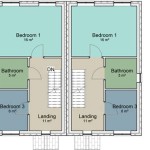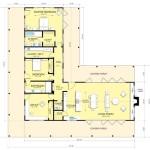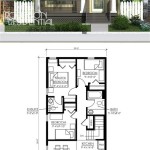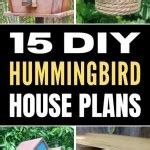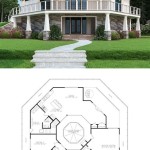House plans with greenhouse are architectural designs that seamlessly integrate a greenhouse into a residential structure. A greenhouse, defined as a transparent, climate-controlled space, allows for the cultivation of plants in environments that would otherwise be unsuitable. Incorporating a greenhouse into a home’s design offers unique advantages, such as extending the growing season, providing a source of fresh produce, and creating a dedicated space for plant enthusiasts.
These house plans cater to individuals seeking a harmonious blend of living space and botanical sanctuary. Whether it’s a small, attached structure adjacent to the kitchen or a grand, standalone greenhouse occupying its own section of the property, these plans provide ample options tailored to various needs and preferences. With considerations for natural light optimization, proper ventilation, and resource efficiency, house plans with greenhouse offer a compelling combination of functionality, aesthetics, and sustainability.
When considering house plans with greenhouse, it’s important to keep in mind key factors that contribute to their functionality and overall appeal:
- Natural light optimization
- Proper ventilation
- Climate control
- Resource efficiency
- Structural integration
- Aesthetic harmony
- Space utilization
- Purposeful design
By carefully considering these elements, homeowners can create a greenhouse space that seamlessly blends with their living environment, providing both practical benefits and aesthetic enjoyment.
Natural light optimization
In greenhouse design, optimizing natural light is crucial for plant growth and overall greenhouse efficiency. Here are key points to consider:
- Orientation and placement: Position the greenhouse to maximize exposure to sunlight throughout the day. A south-facing orientation in the Northern Hemisphere and a north-facing orientation in the Southern Hemisphere are ideal.
- Roof design: Choose roofing materials that allow ample sunlight to penetrate, such as clear glass or polycarbonate panels. Consider incorporating skylights or clerestory windows to enhance natural light distribution.
- Internal shading: Implement shading systems, such as blinds or curtains, to control direct sunlight and prevent overheating during peak hours while still allowing sufficient light for plant growth.
- Reflective surfaces: Utilize reflective materials on the interior walls and surfaces of the greenhouse to maximize light dispersion and minimize light loss.
By optimizing natural light, greenhouses can create ideal growing conditions for plants, reduce energy consumption for artificial lighting, and contribute to a brighter and more inviting living space.
Proper ventilation
Proper ventilation in a greenhouse is essential for maintaining a healthy and controlled environment for plants. It ensures adequate air circulation, temperature regulation, and humidity control, all of which contribute to optimal plant growth and overall greenhouse efficiency.
- Air circulation: Good air circulation prevents stagnant air and promotes the movement of fresh air throughout the greenhouse. This helps distribute heat evenly, minimize disease spread, and provide a steady supply of carbon dioxide for photosynthesis.
- Temperature regulation: Proper ventilation helps regulate temperature by allowing warm air to escape during hot days and preventing cold air from settling during cold nights. Ventilation systems, such as fans or vents, can be used to actively control temperature and maintain optimal growing conditions.
- Humidity control: Ventilation helps manage humidity levels within the greenhouse. By allowing excess moisture to escape, ventilation prevents condensation from forming on plants and reduces the risk of fungal diseases. It also helps maintain a drier environment, which can be beneficial for certain plant species.
- Pollination: Proper ventilation facilitates natural pollination by allowing pollinators, such as insects or wind, to access the greenhouse. This is particularly important for plants that rely on cross-pollination for fruit and seed production.
Ensuring proper ventilation in a greenhouse is crucial for creating a thriving environment for plants while also promoting energy efficiency and reducing the need for artificial climate control systems.
Climate control
Climate control in a greenhouse involves maintaining optimal environmental conditions for plant growth throughout the year, regardless of external weather conditions. It encompasses temperature regulation, humidity management, and air circulation, all of which contribute to a thriving indoor growing environment.
- Temperature regulation: Greenhouses provide a controlled environment where temperature can be adjusted to suit the specific needs of the plants being cultivated. This can be achieved through the use of heating systems, such as furnaces or boilers, to maintain warmth during cold months, and cooling systems, such as air conditioners or evaporative coolers, to regulate temperature during hot weather. Maintaining optimal temperature ranges is crucial for plant growth, flowering, and fruiting.
- Humidity management: Humidity levels within a greenhouse need to be carefully managed to prevent excessive moisture buildup, which can lead to disease and mold growth. Proper ventilation and the use of dehumidifiers can help control humidity levels. Additionally, increasing air circulation within the greenhouse can promote evaporation and reduce overall humidity.
- Air circulation: Good air circulation is essential for distributing heat evenly throughout the greenhouse, preventing stagnant air pockets, and ensuring a steady supply of fresh air for plant respiration. Proper ventilation systems, such as fans or vents, help circulate air and reduce the risk of disease spread by preventing the buildup of stale air.
- Artificial lighting: In areas with limited natural sunlight or during winter months, artificial lighting can be used to supplement or extend the natural light available for plant growth. Grow lights, specifically designed to provide the necessary light spectrum and intensity for photosynthesis, can be used to maintain optimal growing conditions.
Effective climate control in a greenhouse allows for year-round cultivation of a wide variety of plant species, maximizes plant growth and productivity, and reduces the risk of pests and diseases.
Resource efficiency
Resource efficiency in the context of house plans with greenhouse involves optimizing the use of energy, water, and materials to minimize environmental impact and operating costs while maximizing the benefits of greenhouse cultivation.
- Energy efficiency: Greenhouses can be designed to be energy-efficient by incorporating passive solar design principles, such as maximizing natural light and utilizing thermal mass to regulate temperature. Additionally, energy-efficient glazing materials, insulation, and heating and cooling systems can help reduce energy consumption.
- Water conservation: Water-efficient practices, such as rainwater harvesting, drip irrigation systems, and moisture sensors, can help conserve water usage in greenhouses. Utilizing drought-tolerant plants and implementing mulching techniques can further reduce water consumption.
- Material sustainability: Sustainable building materials, such as recycled or renewable resources, can be used in the construction of greenhouses to minimize environmental impact. Choosing durable and low-maintenance materials can also reduce long-term resource consumption associated with repairs and replacements.
- Waste management: Greenhouses can be designed to incorporate waste management practices, such as composting organic waste to create nutrient-rich soil amendments. By reducing waste and maximizing resource utilization, greenhouses can contribute to a more sustainable and environmentally friendly approach to home gardening.
By prioritizing resource efficiency, house plans with greenhouse can not only provide a controlled environment for plant cultivation but also contribute to a more sustainable and eco-conscious lifestyle.
Structural integration
Structural integration refers to the seamless incorporation of a greenhouse into the overall design and structure of a house. It involves carefully considering the greenhouse’s size, shape, and placement in relation to the existing house to ensure a cohesive and functional living space.
- Foundation and support: The greenhouse’s foundation must be carefully designed to provide adequate support and stability, especially in areas with extreme weather conditions. The foundation should be integrated with the house’s foundation to create a strong and unified structure.
- Roof design and materials: The greenhouse’s roof design should complement the architectural style of the house while also meeting the functional requirements of the greenhouse. The choice of roofing materials, such as glass, polycarbonate, or fabric, should consider factors like light transmission, insulation, and durability.
- Glazing and framing: The greenhouse’s glazing and framing system should be designed to maximize natural light transmission while providing structural stability. The framing should be made of durable materials that can withstand varying weather conditions and support the weight of the glazing.
- Ventilation and access: Proper ventilation is crucial for regulating temperature and humidity levels within the greenhouse. Ventilation systems, such as vents or fans, should be seamlessly integrated into the structure to ensure adequate air circulation. Additionally, easy access to the greenhouse from the house is important for maintenance and plant care.
By carefully considering these structural integration aspects, house plans with greenhouse can achieve a harmonious blend of functionality, aesthetics, and structural integrity, creating a cohesive and enjoyable living environment.
Aesthetic harmony
Aesthetic harmony in house plans with greenhouse refers to the seamless integration of the greenhouse’s design and structure with the overall architectural style of the house. It involves carefully considering the greenhouse’s size, shape, and placement to create a cohesive and visually appealing living space.
One important aspect of achieving aesthetic harmony is to match the greenhouse’s architectural style to the house. For example, a traditional-style house might be complemented by a greenhouse with a classic Victorian or Edwardian design, featuring intricate detailing and ornate glasswork. A modern house, on the other hand, might be paired with a minimalist greenhouse with clean lines, geometric shapes, and large expanses of glass.
Another key consideration is the placement of the greenhouse in relation to the house. The greenhouse should be positioned to maximize natural light exposure while also complementing the overall flow and layout of the house. For instance, a greenhouse attached to the south side of the house can provide ample sunlight for plants and create a seamless transition between indoor and outdoor living spaces.
Finally, the materials used in the construction of the greenhouse should be carefully chosen to harmonize with the house’s exterior. For example, a house with a brick exterior might be paired with a greenhouse featuring brick accents or a wooden frame. By carefully considering these factors, house plans with greenhouse can achieve a high degree of aesthetic harmony, creating a visually cohesive and inviting living environment.
Space utilization
Space utilization in house plans with greenhouse is a crucial aspect that involves optimizing the available space to maximize functionality and create a comfortable living environment. Here are some key considerations for efficient space utilization in house plans with greenhouse:
Vertical gardening: Vertical gardening techniques can be employed to maximize space utilization in greenhouses. By utilizing vertical space through trellises, hanging planters, or stacked shelves, a wide variety of plants can be grown in a limited footprint. This approach is particularly beneficial for small greenhouses or those with limited horizontal space.
Multipurpose areas: Integrating multipurpose areas into the greenhouse design can enhance space utilization and functionality. For instance, incorporating a seating area or a small work desk within the greenhouse can create a space for relaxation, plant care, or other activities, without compromising the growing area.
Efficient storage solutions: Implementing efficient storage solutions, such as built-in shelves, cabinets, or drawers, can help keep tools, supplies, and other items organized and easily accessible. Vertical storage options, such as pegboards or wall-mounted organizers, can further optimize space utilization.
Greenhouse as extension of living space: In some house plans, the greenhouse is designed as an extension of the living space, seamlessly connecting indoor and outdoor environments. This approach allows for the integration of the greenhouse into the home’s overall design, creating a cohesive and expansive living area.
By carefully considering space utilization in house plans with greenhouse, homeowners can create a functional and aesthetically pleasing living environment that maximizes the benefits of greenhouse cultivation while optimizing the available space.
Purposeful design
Purposeful design in house plans with greenhouse involves carefully considering the specific needs and preferences of the homeowners to create a space that meets their unique requirements and aspirations. This approach ensures that the greenhouse is not just an add-on but an integral part of the home’s overall design and functionality.
- Hobbyist’s haven: For avid gardeners and plant enthusiasts, a greenhouse can serve as a dedicated space to pursue their passion. The design should consider factors such as ample growing space, specialized lighting, and convenient access to tools and supplies.
- Year-round produce: Homeowners seeking to cultivate their own food year-round can benefit from a greenhouse designed to optimize growing conditions for specific crops. This may involve incorporating raised beds, trellises, or automated irrigation systems to maximize productivity and minimize maintenance.
- Wellness and relaxation: Greenhouses can also be designed to promote well-being and relaxation. Incorporating comfortable seating areas, natural ventilation, and calming plants can create a serene and rejuvenating space for homeowners to unwind and connect with nature.
- Educational resource: For families with children or those interested in botany, a greenhouse can serve as an educational tool. The design should include features such as designated areas for plant propagation, observation windows, and interactive displays to foster learning and inspire a love for nature.
By embracing purposeful design, house plans with greenhouse can transform these spaces into highly functional and tailored environments that seamlessly integrate with the homeowners’ lifestyle and aspirations.





:max_bytes(150000):strip_icc()/howto-specialist-greenhouse-582f1e843df78c6f6a01a0c2.png)
:max_bytes(150000):strip_icc()/greenhouse-buildeazy-5b69c8a546e0fb0050666b57.jpg)



Related Posts


